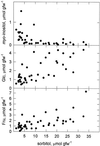Sorbitol-6-phosphate dehydrogenase expression in transgenic tobacco. High amounts of sorbitol lead to necrotic lesions
- PMID: 9662525
- PMCID: PMC34937
- DOI: 10.1104/pp.117.3.831
Sorbitol-6-phosphate dehydrogenase expression in transgenic tobacco. High amounts of sorbitol lead to necrotic lesions
Abstract
We analyzed transgenic tobacco (Nicotiana tabacum L.) expressing Stpd1, a cDNA encoding sorbitol-6-phosphate dehydrogenase from apple, under the control of a cauliflower mosaic virus 35S promoter. In 125 independent transformants variable amounts of sorbitol ranging from 0.2 to 130 &mgr;mol g-1 fresh weight were found. Plants that accumulated up to 2 to 3 &mgr;mol g-1 fresh weight sorbitol were phenotypically normal, with successively slower growth as sorbitol amounts increased. Plants accumulating sorbitol at 3 to 5 &mgr;mol g-1 fresh weight occasionally showed regions in which chlorophyll was partially lost, but at higher sorbitol amounts young leaves of all plants lost chlorophyll in irregular spots that developed into necrotic lesions. When sorbitol exceeded 15 to 20 &mgr;mol g-1 fresh weight, plants were infertile, and at even higher sorbitol concentrations the primary regenerants were incapable of forming roots in culture or soil. In mature plants sorbitol amounts varied with age, leaf position, and growth conditions. The appearance of lesions was correlated with high sorbitol, glucose, fructose, and starch, and low myo-inositol. Supplementing myo-inositol in seedlings and young plants prevented lesion formation. Hyperaccumulation of sorbitol, which interferes with inositol biosynthesis, seems to lead to osmotic imbalance, possibly acting as a signal affecting carbohydrate allocation and transport.
Figures




Similar articles
-
Sorbitol synthesis in transgenic tobacco with apple cDNA encoding NADP-dependent sorbitol-6-phosphate dehydrogenase.Plant Cell Physiol. 1995 Apr;36(3):525-32. doi: 10.1093/oxfordjournals.pcp.a078789. Plant Cell Physiol. 1995. PMID: 7757342
-
Engineered sorbitol accumulation induces dwarfism in Japanese persimmon.J Plant Physiol. 2004 Oct;161(10):1177-84. doi: 10.1016/j.jplph.2004.04.009. J Plant Physiol. 2004. PMID: 15535127
-
An engineered sorbitol cycle alters sugar composition, not growth, in transformed tobacco.Plant Cell Environ. 2006 Oct;29(10):1980-8. doi: 10.1111/j.1365-3040.2006.01573.x. Plant Cell Environ. 2006. PMID: 16930323
-
Down-regulation of sorbitol dehydrogenase and up-regulation of sucrose synthase in shoot tips of the transgenic apple trees with decreased sorbitol synthesis.J Exp Bot. 2006;57(14):3647-57. doi: 10.1093/jxb/erl112. Epub 2006 Sep 15. J Exp Bot. 2006. PMID: 16980595
-
Transformation of Japanese persimmon (Diospyros kaki Thunb.) with apple cDNA encoding NADP-dependent sorbitol-6-phosphate dehydrogenase.Plant Sci. 2001 Apr;160(5):837-845. doi: 10.1016/s0168-9452(00)00458-1. Plant Sci. 2001. PMID: 11297780
Cited by
-
Identification and functional characterization of sorbitol-6-phosphate dehydrogenase protein from rice and structural elucidation by in silico approach.Planta. 2014 Jul;240(1):223-38. doi: 10.1007/s00425-014-2076-4. Epub 2014 May 11. Planta. 2014. PMID: 24817585
-
Plant responses to drought, salinity and extreme temperatures: towards genetic engineering for stress tolerance.Planta. 2003 Nov;218(1):1-14. doi: 10.1007/s00425-003-1105-5. Epub 2003 Sep 26. Planta. 2003. PMID: 14513379 Review.
-
Rootstock effects on gene expression patterns in apple tree scions.Plant Mol Biol. 2003 Nov;53(4):493-511. doi: 10.1023/B:PLAN.0000019122.90956.3b. Plant Mol Biol. 2003. PMID: 15010615
-
Versatile roles of sorbitol in higher plants: luxury resource, effective defender or something else?Planta. 2022 Jun 17;256(1):13. doi: 10.1007/s00425-022-03925-z. Planta. 2022. PMID: 35713726 Review.
-
Expression of the ggpPS gene for glucosylglycerol biosynthesis from Azotobacter vinelandii improves the salt tolerance of Arabidopsis thaliana.J Exp Bot. 2009;60(6):1679-89. doi: 10.1093/jxb/erp030. Epub 2009 Apr 10. J Exp Bot. 2009. PMID: 19363207 Free PMC article.
References
-
- Adams P, Thomas JC, Vernon DM, Bohnert HJ, Jensen RG. Distinct cellular and organismic response to salt stress. Plant Cell Physiol. 1992;33:1215–1223.
-
- Adams P, Zegeer A, Bohnert HJ, Jensen RG. Anion exchange separation and pulsed amperometric detection of inositols from flower petals. Anal Biochem. 1993;214:321–324. - PubMed
-
- Asada K. Production and action of active oxygen species in photosynthetic tissues. In: Foyer CH, Mullineaux PM, editors. Causes of Photooxidative Stress and Amelioration of Defense Systems in Plants. London: CRC Press; 1994. pp. 77–105.
-
- Baillieul F, Genetet I, Kopp M, Saindrenan P, Fritig B, Kauffmann S. A new elicitor of the hypersensitive response in tobacco: a fungal glycoprotein elicits cell death, expression of defence genes, production of salicylic acid, and induction of systemic acquired resistance. Plant J. 1995;8:551–560. - PubMed
-
- Becker F, Buschfeld E, Schell J, Bachmair A. Altered response to viral infection in tobacco plants perturbed in ubiquitin system. Plant J. 1993;3:875–881.
LinkOut - more resources
Full Text Sources

